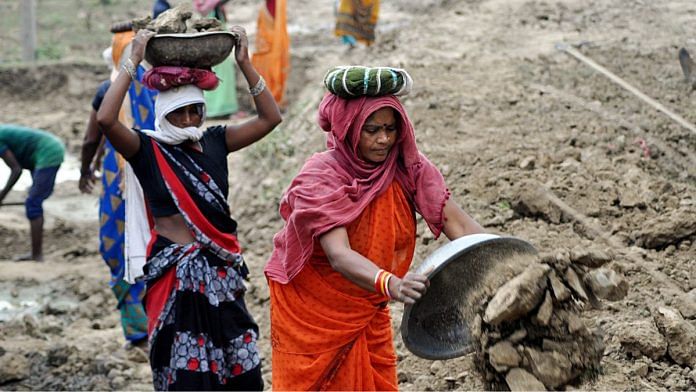Thank you dear subscribers, we are overwhelmed with your response.
Your Turn is a unique section from ThePrint featuring points of view from its subscribers. If you are a subscriber, have a point of view, please send it to us. If not, do subscribe here: https://theprint.in/subscribe/
The Mahatma Gandhi National Rural Employment Guarantee Act (MGNREGA), introduced in 2005, remains one of India’s most transformative social protection laws. It provides a legal right to employment by guaranteeing 100 days of paid unskilled manual labour each year to rural households seeking work. More than a welfare initiative, the scheme aims to ensure economic security, reduce rural distress, and support inclusive development.
Rural India faces enduring problems such as seasonal joblessness, insufficient incomes, and limited access to markets and services. These challenges often drive families into cycles of debt and migration. By offering employment close to home and creating assets like irrigation systems, rural roads, and water bodies, MGNREGA attempts to both stabilize incomes and improve rural infrastructure.
Core Features of MGNREGA
One of the act’s defining aspects is its legal guarantee: employment must be provided within 15 days of demand, failing which workers are entitled to an unemployment allowance. Eligible households must first register with the Gram Panchayat to receive a job card, which records all work demanded and completed.
The program follows a bottom-up structure, where Gram Sabhas and Panchayati Raj Institutions are central to planning and oversight. Work undertaken under MGNREGA often focuses on water conservation, soil development, drought prevention, and land productivity. Notably, over half of all workers are women, making the scheme a critical force for rural gender empowerment. Funding responsibilities are shared, with the central government covering most unskilled wage payments, while states contribute to skilled labour, materials, and administration.
SWOT Analysis of MGNREGA
One of MGNREGA’s biggest strengths is its legal foundation, which treats employment as a right rather than a benefit. This shifts the power dynamic in favour of citizens, giving them the ability to demand accountability. The scheme has also succeeded in promoting social inclusion, reaching vulnerable communities such as Scheduled Castes, Scheduled Tribes, and women. The decentralized nature of implementation ensures local needs are prioritized. Environmental goals are also embedded in the scheme, with activities aimed at land and water restoration. Furthermore, tools such as social audits, digital tracking, and public disclosure have improved transparency and reduced leakages in many areas.
Despite its successes, MGNREGA faces significant weaknesses, particularly in execution. Delayed wage payments, irregular monitoring, and inadequate staffing have affected its impact. In many villages, low awareness prevents eligible households from enrolling or fully understanding their rights. While the law promises 100 days of work annually, actual employment days often fall short. Participation is also uneven due to seasonal farm work and the physically demanding nature of tasks, which may discourage certain groups, especially older or disabled individuals. Additionally, corruption in the form of fake job cards or inflated attendance records remains a concern in some regions.
There are clear opportunities to strengthen the scheme further. With better planning and timely payments, MGNREGA can help revive rural economies, reduce urban migration, and create sustainable village infrastructure. The scheme can be effectively linked with other rural development programs like Swachh Bharat Abhiyan or PMAY, amplifying its impact. It also holds potential for deepening grassroots democracy, as local bodies become more involved in governance, budgeting, and project execution.
However, certain threats could undermine MGNREGA’s effectiveness. In areas with poor governance, political interference and turf battles between local officials and elected representatives can derail the program. Budgetary constraints, rising material costs, and inflation may limit how far the scheme can go. Moreover, exclusion of migrant workers—many of whom lack local documentation—continues to be a challenge. Finally, changing policy priorities, especially with growing emphasis on privatization and market reforms, could lead to reduced focus on rural employment guarantees.
Conclusion
MGNREGA is a bold and ambitious step toward ensuring livelihood security for millions in rural India. It offers more than just employment—it brings dignity, participation, and a stake in local development. For the act to fulfill its original promise, stronger implementation, increased awareness, and consistent funding are essential. In a country where economic disparities remain wide, MGNREGA continues to be a cornerstone in the pursuit of inclusive and equitable growth.
These pieces are being published as they have been received – they have not been edited/fact-checked by ThePrint.


